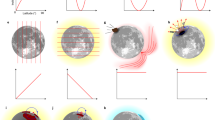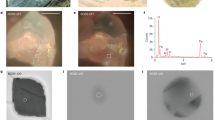Abstract
Interpreting the past latitude and geography of the continents from palaeomagnetic data relies on the key assumption that Earth’s geomagnetic field behaves as a geocentric axial dipole. The axial dipolar field model implies that all geomagnetic reversals should be symmetric. However, palaeomagnetic data from volcanic rocks produced by the 1.1-billion-year-old Keweenawan Rift system in North America have been interpreted to show asymmetric reversals, which had led to the suggestion that there was a significant non-axial dipole contribution to the magnetic field during this time1,2. Here we present high-resolution palaeomagnetic data that span three geomagnetic field reversals from a well-described series of basalt flows at Mamainse Point, Ontario, in the Keweenawan Rift. Our data show that each reversal is symmetric. We thus conclude that the previously documented reversal asymmetry is an artefact of the rapid motion of North America during this time. Comparisons of reversed and normal populations that were time-averaged over entire polarity intervals, or from sites not directly on either side of a geomagnetic reversal, have previously led to the appearance of reversal asymmetry.
This is a preview of subscription content, access via your institution
Access options
Subscribe to this journal
Receive 12 print issues and online access
$259.00 per year
only $21.58 per issue
Buy this article
- Purchase on Springer Link
- Instant access to full article PDF
Prices may be subject to local taxes which are calculated during checkout




Similar content being viewed by others
Change history
13 April 2010
In the version of this Letter originally published, Supplementary Tables S2, S3 and S4 contained several errors. Consequently, the estimates of the rate of motion on page 716 should have read: "The estimates for the rate of motion from 1,108 Myr to 1,097 Myr range between 21.5±7.1 cm yr−1 for Osler Volcanics reversed→North Shore normal, to 33.6±3.5 cm yr−1 for Coldwell Complex reversed→North Shore normal." Furthermore, the position of the Duluth Complex reversed pole in Fig. 3a and the positions of the lower normal and upper normal palaeopoles in Fig. 3b were slightly incorrect. These errors have been corrected in the HTML and PDF versions of the text.
References
Pesonen, L. & Nevanlinna, H. Late Precambrian Keweenawan asymmetric reversals. Nature 294, 436–439 (1981).
Nevanlinna, H. & Pesonen, L. Late Precambrian Keweenawan asymmetric polarities as analyzed by axial offset dipole geomagnetic models. J. Geophys. Res. 88, 645–658 (1983).
Van Schmus, W. R. & Hinze, W. J. The midcontinent rift system. Annu. Rev. Earth Planet. Sci. 13, 345 (1985).
Halls, H. & Pesonen, L. Paleomagnetism of Keweenawan rocks. Geol. Soc. Am. Mem. 156, 173–201 (1982).
Dubois, P. Paleomagnetism and correlation of Keweenawan rocks. Bull. Geol. Surv. Can. 71, 1–75 (1962).
Robertson, W. & Fahrig, W. The great Logan Loop—the polar wandering path from Canadian shield rocks during the Neohelikian era. Can. J. Earth Sci. 8, 1355–1372 (1971).
Weil, A., Van der Voo, R., Mac Niocaill, C. & Meert, J. The Proterozoic supercontinent Rodinia: Paleomagnetically derived reconstructions for 1100 to 800 Ma. Earth Planet. Sci. Lett. 154, 13–24 (1998).
Buchan, K. et al. Rodinia: The evidence from integrated palaeomagnetism and U–Pb geochronology. Precambr. Res. 110, 9–32 (2001).
Piper, J. The Neoproterozoic supercontinent Palaeopangea. Gondwana Res. 12, 202–227 (2007).
Kent, D. & Smethurst, M. Shallow bias of paleomagnetic inclinations in the Paleozoic and Precambrian. Earth Planet. Sci. Lett. 160, 391–402 (1998).
Evans, D. Stratigraphic, geochronological, and paleomagnetic constraints upon the Neoproterozoic climatic paradox. Am. J. Sci. 300, 347–433 (2000).
Maloof, A. et al. Combined paleomagnetic, isotopic and stratigraphic evidence for true polar wander from the Neoproterozoic Akademikerbreen Group, Svalbard, Norway. GSA Bull. 118, 1099–1124 (2006).
Palmer, H. Paleomagnetism and correlation of some Middle Keweenawan rocks, Lake Superior. Can. J. Earth Sci. 7, 1410–1436 (1970).
Robertson, W. Pole positions from the Mamainse Point Lavas and their bearing on a Keweenawan pole path. Can. J. Earth Sci. 10, 1541–1555 (1973).
Hanson, R. et al. Coeval large-scale magmatism in the Kalahari and Laurentian Cratons during Rodinia assembly. Science 304, 1126–1129 (2004).
Shirey, S., Klewin, K., Berg, J. & Carlson, R. Temporal changes in the sources of flood basalts: Isotopic and trace element evidence for the 1100 Ma old Keweenawan Mamainse Point Formation, Ontario, Canada. Geochim. Cosmochim. Acta 58, 4475–4490 (1994).
Symons, D. et al. Synopsis of paleomagnetic studies in the Kapuskasing structural zone. Can. J. Earth Sci. 31, 1206–1217 (1994).
Lewchuk, M. & Symons, D. Paleomagnetism of the Late Precambrian Coldwell Complex. Tectonophysics 184, 73–86 (1990).
McFadden, P. & McElhinny, M. Classification of the reversal test in palaeomagnetism. Geophys. J. Int. 103, 725–729 (1990).
McElhinny, M., McFadden, P. & Merrill, R. The time-averaged paleomagnetic field 0–5 Ma. J. Geophys. Res. 101, 25007–25027 (1996).
Besse, J. & Courtillot, V. Apparent and true polar wander and the geometry of the geomagnetic field over the last 200 Myr. J. Geophys. Res. 107, 2300 (2002).
Evans, D. Proterozoic low orbital obliquity and axial-dipolar geomagnetic field from evaporite palaeolatitudes. Nature 444, 51–55 (2006).
Tauxe, L. & Kent, D. in Timescales of the Paleomagnetic Field Vol. 145 of Geophysical Monograph (eds Channell, J., Kent, D., Lowrie, W. & Meert, J.) 101–116 (American Geophysical Union, 2004).
Elston, D. P., Enkin, R. J., Baker, J. & Kisilevsky, D. K. Tightening the belt: Paleomagnetic-stratigraphic constraints on deposition, correlation, and deformation of the middle Proterozoic (ca. 1.4 Ga) Belt-Purcell supergroup, United States and Canada. GSA Bull. 114, 619–638 (2002).
Gallet, Y., Pavlov, V., Semikhatov, M. & Petrov, P. Late Mesoproterozoic magnetostratigraphic results from Siberia: Paleogeographic implications and magnetic field behavior. J. Geophys. Res. 105, 16481–16499 (2000).
Davis, D. & Green, J. Geochronology of the North American Midcontinent rift in western Lake Superior and implications for its geodynamic evolution. Can. J. Earth Sci. 34, 476–488 (1997).
Conrad, C. & Hager, B. Mantle convection with strong subduction zones. Geophys. J. Int. 144, 271–288 (2001).
Evans, D. True polar wander and supercontinents. Tectonophysics 362, 303–320 (2003).
Kirschvink, J. The least-squares line and plane and the analysis of paleomagnetic data. Geophys. J. R. Astron. Soc. 62, 699–718 (1980).
Giblin, P. E. Preliminary Geological Maps 553–555 (Ontario Department of Mines, 1969).
Acknowledgements
We thank D. Jones, C. Rose and N. Eichelberger for field assistance; C. Bayne of Bay Niche Conservancy for land access; D. Kent and M. Jackson for assistance with hysteresis experiments; J. Kasbohm for help drafting the geological map; J. Kirschvink for support of pilot analyses at the Caltech Paleomagnetics Laboratory; and R. Mitchell and T. Kilian for support in the Yale palaeomagnetism facility, which was funded by NSF and the David and Lucile Packard Foundation. This work has benefited from discussions with D. Davis, J. Feinberg, H. Halls, D. Kent, B. Kopp, T. Raub and L. Tauxe. D. Bice encouraged N.L.S.-H. to begin study of Keweenawan volcanics when N.L.S.-H. was an undergraduate at Carleton College. This work was financially supported through a Sigma Xi Grant-In-Aid awarded to N.L.S.-H., A.C.M.’s Agouron Post-doctoral fellowship and Princeton University. B.P.W. acknowledges support from the NSF Geophysics Program.
Author information
Authors and Affiliations
Contributions
Fieldwork was conducted by N.L.S.-H. (2 field seasons), A.C.M. (2 field seasons) and B.P.W. (1 field season) following initial project planning by A.C.M. and subsequent project planning by A.C.M. and N.L.S.-H. Samples were analysed by N.L.S.-H. in the laboratories of D.A.D.E. and B.P.W. N.L.S.-H. analysed the data, wrote the manuscript and drafted Figs 2–3 with input from A.C.M., B.P.W. and D.A.D.E. Figure 1 was drafted by A.C.M. and N.L.S.-H.
Corresponding author
Supplementary information
Supplementary Information
Supplementary Information (PDF 1815 kb)
Rights and permissions
About this article
Cite this article
Swanson-Hysell, N., Maloof, A., Weiss, B. et al. No asymmetry in geomagnetic reversals recorded by 1.1-billion-year-old Keweenawan basalts. Nature Geosci 2, 713–717 (2009). https://doi.org/10.1038/ngeo622
Received:
Accepted:
Published:
Issue Date:
DOI: https://doi.org/10.1038/ngeo622
This article is cited by
-
Deconstructing plate tectonic reconstructions
Nature Reviews Earth & Environment (2023)
-
True polar wander in the Earth system
Science China Earth Sciences (2023)
-
Constraining the isotopic endmembers contributing to 1.1 Ga Keweenawan large igneous province magmatism
Contributions to Mineralogy and Petrology (2022)
-
Accretion mode of oceanic ridges governed by axial mechanical strength
Nature Geoscience (2018)
-
Geology: North America's broken heart
Nature (2013)



